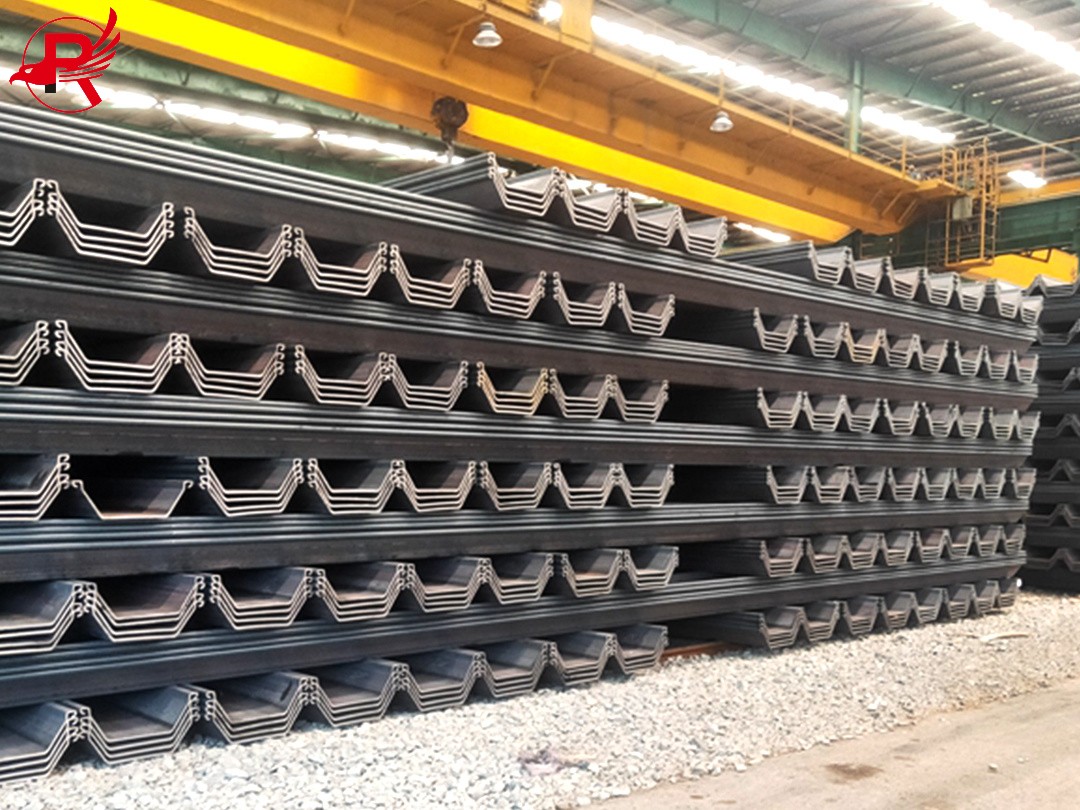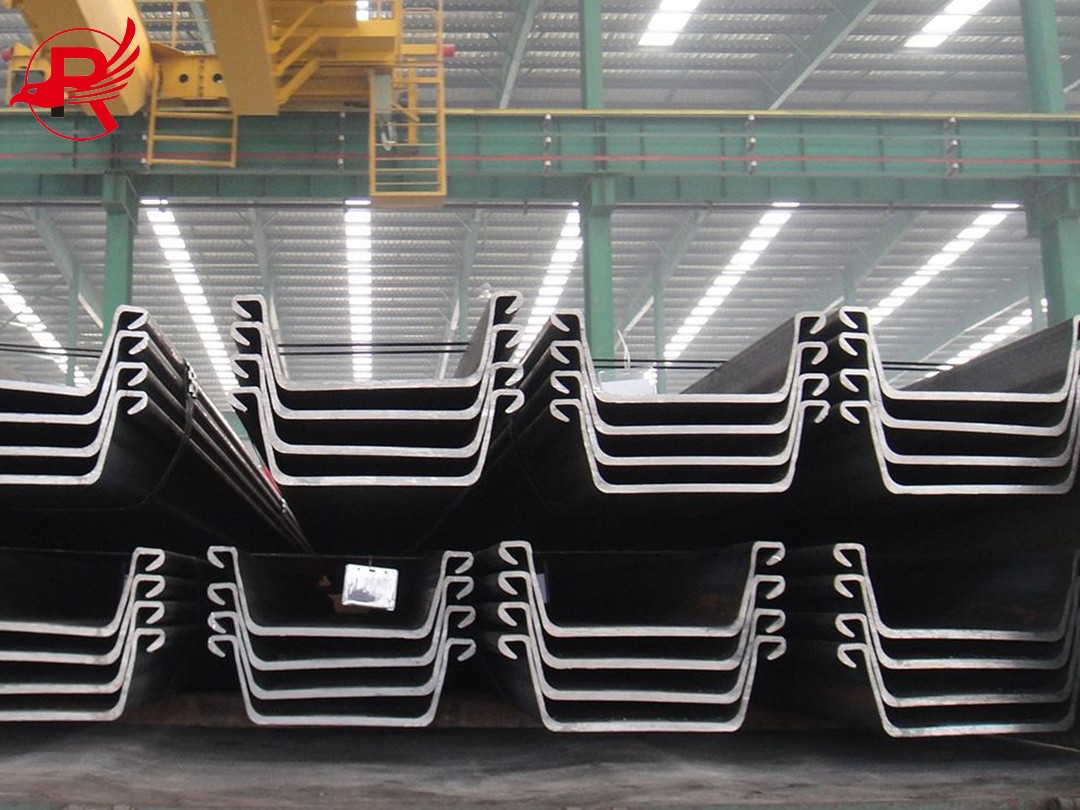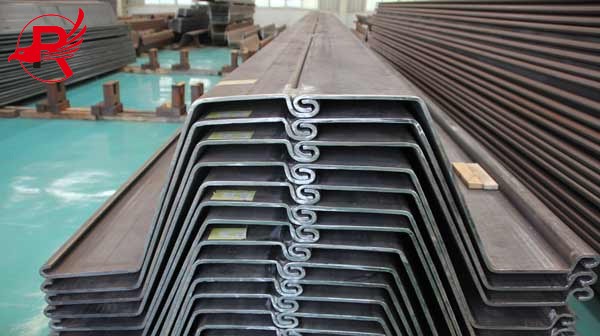Introduction to Steel Sheet Piles
Steel sheet piles are a type of steel with interlocking joints. They come in various cross-sections, including straight, channel, and Z-shaped, and in various sizes and interlocking configurations. Common types include Larsen and Lackawanna. Their advantages include high strength, ease of driving into hard soil, and the ability to be constructed in deep water, with the addition of diagonal supports to create a cage when necessary. They offer excellent waterproofing properties, can be formed into cofferdams of various shapes, and are reusable, making them versatile.

Characteristics of U-shaped steel sheet piles
1. The WR series steel sheet piles feature a rational cross-sectional design and advanced forming technology, resulting in a continuously improved cross-sectional modulus-to-weight ratio. This allows for optimal economic benefits and broadens the application range of cold-formed sheet piles.
2. WRU-type steel sheet piles are available in a wide range of specifications and models.
3. Designed and manufactured according to European standards, their symmetrical structure facilitates reuse, equivalent to hot-rolled steel, and offers a certain degree of angular freedom to correct construction deviations.
4. The use of high quality carbon steel sheet pile and advanced production equipment ensures the performance of cold-formed sheet piles.
5. Custom lengths can be customized to meet customer requirements, greatly facilitating construction and reducing costs.
6. Due to their ease of production, pre-orders can be made for use with modular piles.
7. The design and production cycle is short, and sheet pile performance can be customized to meet customer requirements.

Features of U-shaped steel sheet piles
1. Cold-Formed Steel Sheet Piles: Versatile and Cost-Effective
Cold-formed steel sheet piles are made by bending thin steel sheets into the desired shape. They are cost-effective and versatile, suitable for a variety of construction scenarios. Their light weight makes them easier to handle and transport, reducing construction time and costs. Cold-formed steel sheet piles are ideal for projects with medium load requirements, such as small retaining walls, temporary excavations, and landscaping.
2. Hot-Rolled Steel Sheet Piles: Unparalleled Strength and Durability
Hot-rolled steel sheet piles, on the other hand, are made by heating the steel to a high temperature and then rolling it into the desired shape. This process increases the steel's strength and durability, making them ideal for heavy-duty applications. Their interlocking design ensures stability and can withstand greater pressure and load capacity. Therefore, hot-rolled sheet piles are often used in large-scale construction projects, such as deep excavations, port infrastructure, flood control systems, and high-rise building foundations.
Advantages of U-shaped steel sheet piles
1.U-shaped steel sheet piles are available in a wide variety of sizes and models.
2.Designed and manufactured according to European standards, their symmetrical structure facilitates reuse, making them equivalent to hot-rolled steel.
3. Lengths can be customized to meet customer requirements, greatly facilitating construction while reducing costs.
4.Due to their ease of production, they can be pre-ordered for use with modular piles.
5.Design and production cycles are short, and sheet pile performance can be customized to meet customer requirements.
Common specifications of U-shaped steel sheet piles
| Type | Width | Height | Thickness | Sectional area | Weight per pile | Weight per wall | Moment of Inertia | Modulus of section |
| mm | mm | mm | Cm2/m | Kg/m | Kg/ m2 | Cm4/m | Cm3/m | |
| WRU7 | 750 | 320 | 5 | 71.3 | 42 | 56 | 10725 | 670 |
| WRU8 | 750 | 320 | 6 | 86.7 | 51 | 68.1 | 13169 | 823 |
| WRU9 | 750 | 320 | 7 | 101.4 | 59.7 | 79.6 | 15251 | 953 |
| WRU10-450 | 450 | 360 | 8 | 148.6 | 52.5 | 116.7 | 18268 | 1015 |
| WRU11-450 | 450 | 360 | 9 | 165.9 | 58.6 | 130.2 | 20375 | 1132 |
| WRU12-450 | 450 | 360 | 10 | 182.9 | 64.7 | 143.8 | 22444 | 1247 |
| WRU11-575 | 575 | 360 | 8 | 133.8 | 60.4 | 105.1 | 19685 | 1094 |
| WRU12-575 | 575 | 360 | 9 | 149.5 | 67.5 | 117.4 | 21973 | 1221 |
| WRU13-575 | 575 | 360 | 10 | 165 | 74.5 | 129.5 | 24224 | 1346 |
| WRU11-600 | 600 | 360 | 8 | 131.4 | 61.9 | 103.2 | 19897 | 1105 |
| WRU12-600 | 600 | 360 | 9 | 147.3 | 69.5 | 115.8 | 22213 | 1234 |
| WRU13-600 | 600 | 360 | 10 | 162.4 | 76.5 | 127.5 | 24491 | 1361 |
| WRU18- 600 | 600 | 350 | 12 | 220.3 | 103.8 | 172.9 | 32797 | 1874 |
| WRU20- 600 | 600 | 350 | 13 | 238.5 | 112.3 | 187.2 | 35224 | 2013 |
| WRU16 | 650 | 480 | 8 | 138.5 | 71.3 | 109.6 | 39864 | 1661 |
| WRU 18 | 650 | 480 | 9 | 156.1 | 79.5 | 122.3 | 44521 | 1855 |
| WRU20 | 650 | 540 | 8 | 153.7 | 78.1 | 120.2 | 56002 | 2074 |
| WRU23 | 650 | 540 | 9 | 169.4 | 87.3 | 133 | 61084 | 2318 |
| WRU26 | 650 | 540 | 10 | 187.4 | 96.2 | 146.9 | 69093 | 2559 |
| WRU30-700 | 700 | 558 | 11 | 217.1 | 119.3 | 170.5 | 83139 | 2980 |
| WRU32-700 | 700 | 560 | 12 | 236.2 | 129.8 | 185.4 | 90880 | 3246 |
| WRU35-700 | 700 | 562 | 13 | 255.1 | 140.2 | 200.3 | 98652 | 3511 |
| WRU36-700 | 700 | 558 | 14 | 284.3 | 156.2 | 223.2 | 102145 | 3661 |
| WRU39-700 | 700 | 560 | 15 | 303.8 | 166.9 | 238.5 | 109655 | 3916 |
| WRU41-700 | 700 | 562 | 16 | 323.1 | 177.6 | 253.7 | 117194 | 4170 |
| WRU 32 | 750 | 598 | 11 | 215.9 | 127.1 | 169.5 | 97362 | 3265 |
| WRU 35 | 750 | 600 | 12 | 234.9 | 138.3 | 184.4 | 106416 | 3547 |
| WRU 38 | 750 | 602 | 13 | 253.7 | 149.4 | 199.2 | 115505 | 3837 |
| WRU 40 | 750 | 598 | 14 | 282.2 | 166.1 | 221.5 | 119918 | 4011 |
| WRU 43 | 750 | 600 | 15 | 301.5 | 177.5 | 236.7 | 128724 | 4291 |
| WRU 45 | 750 | 602 | 16 | 320.8 | 188.9 | 251.8 | 137561 | 4570 |

Application of Steel Sheet Piles
Hydraulic Engineering - Ports-Transport Route Structures - Roads and Railways:
1. Dock walls, maintenance walls, retaining walls;
2. Dock and shipyard construction, noise isolation walls;
3. Piers, bollards (docks), bridge foundations;
4. Radar rangefinders, ramps, slopes;
5. Sunken railways, groundwater retention;
6. Tunnels.
Waterway Civil Engineering:
1. Waterway maintenance;
2. Retaining walls;
3. Roadbed and embankment reinforcement;
4. Mooring equipment; scour prevention.
Pollution Control for Water Conservancy Projects - Contaminated Areas, Fences and Fills:
1.
(River) Locks, Sluice Gates: Vertical, Sealing Fences;
2.
Weirs, Dams: Excavations for soil replacement;
3.
Bridge Foundations: Waterway enclosures;
4.
(Highway, Railway, etc.) Culverts: Protective underground cableways at the top of slopes;
5.
Emergency Gates;
6.
Flood Dikes: Noise Reduction;
7.
Bridge Pillars, Piers: Noise Isolation Walls; Entrances and Exits.
China Royal Steel Ltd
Address
Bl20, Shanghecheng, Shuangjie Street, Beichen District, Tianjin, China
Phone
+86 13652091506
Post time: Aug-15-2025
